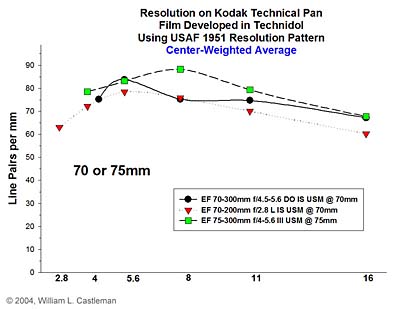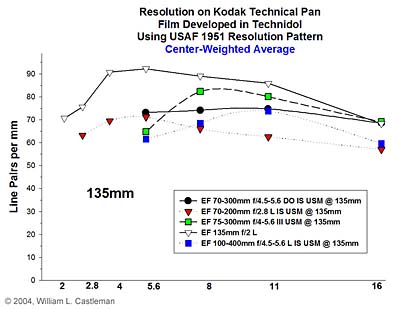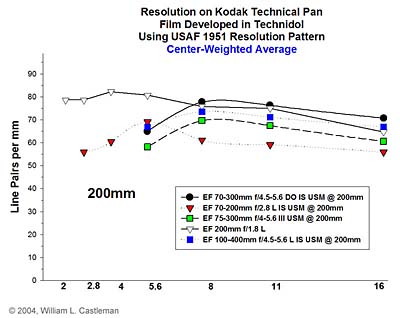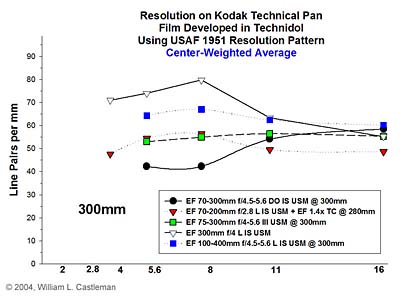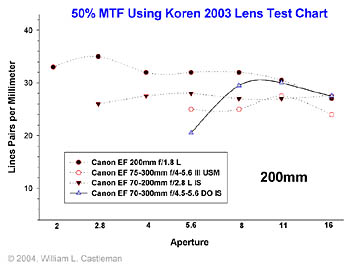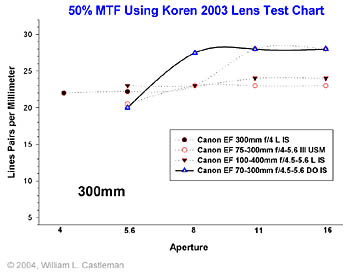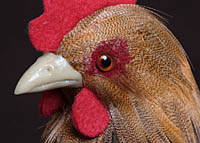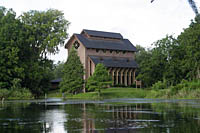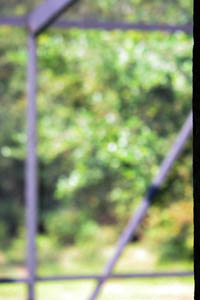Review of the
Canon EF 70-300mm f/4.5-5.6 DO IS Lens
I was interested in finding a compact, relatively light telephoto zoom
lens in the 75-300mm range to put in a light kit with wide-angle zoom that
I could travel easily with and use for grab and shoot purposes
with my Canon APS-C camera (20D / D60). Ideally, it would yield reasonable
quality prints that I could enlarge well above an 8x10 inch print size if
needed. I compared two compact Canon zoom telephoto lenses with other
larger, heavier lenses. This review focuses on comparisons between Canon's
relatively expensive EF 70-300mm f/4.5-5.6 DO IS lens based on diffractive
optics against the inexpensive EF 75-300mm f/4-5.6 III USM.
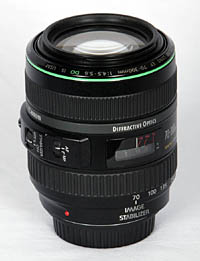
Canon
EF 70-300mm f/4.5-5.6 DO IS USM Lens |
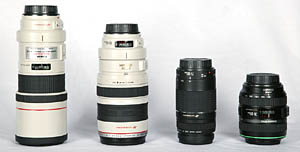
Lenses
Used in Tests
Which of these 300mm lenses would you want to
carry all day on your shoulder, back or around your neck, and how much
lens performance are you willing to sacrifice?
Click
here for lens specification on size and weight. |
| Review
Summary for Canon EF 70-300mm f/4.5-5.6 DO IS USM Lens |
Lens strengths:
- Compact and relatively light
- Overall excellent image quality from 70 to 200mm
- Well built
- Fast focusing function (even with a D60)
- Image stabilization works superbly for low ambient light uses
|
Lens weaknesses:
- Mediocre image quality at 300mm. You will be disappointed with
the 70-300mm DO at 300mm if you have ever shot with a good EF 300mm
prime lens or a higher quality zoom such as the EF 100-400mm L IS at
300mm. These latter two lenses offer noticeably sharper images in
enlargements above 8x10 inches (A4).
- Image-destroying
lens flare under conditions of moderately bright background
lighting into the lens. This lens is more prone to flare than any
other lens I have used.
- High cost
|
Resolution and Modulation Transfer
Function
Resolution
Resolution of the EF 70-300mm f/4.5-5.6 DO IS lens was found to be
comparable to other Canon zoom telephoto lenses tested in the range from
70mm through 200mm. Resolution of greater than 60 line pairs per mm was
achieved at all focal lengths tested except at 300mm. Images produced by
the lens were free of significant chromatic aberration at all focal
lengths tested. At 300mm, the EF 70-300mm f/4.5-5.6 DO IS lens was only
able to achieve resolution ranging from low 40's to high 50's line pairs
per mm. Photographs of birds and other wildlife taken at 300mm and
enlarged beyond 8x10 inch print levels noticeably lacked the sharpness and
contrast that were achievable with a 300mm prime lens.
Method for Lens Resolution
Measurement with Kodak Technical Pan
Digital Camera 50% MTF at 200mm and 300mm
What the EF 70-300mm f/4.5-5.6 DO lens lacks in resolution at 300mm, it
appears to make up for with higher contrast and higher MTF scores. 50% MTF
was calculated at 200mm and 300mm using this
method.
|
Comparison of Image
Sharpness at 300mm |
Comparison of Image
Sharpness Various Focal Lengths |
|
Bokeh of the EF 70-300mm
f/4.5-5.6 |
Lense Flare of the EF
70-300mm f/4.5-5.6 |
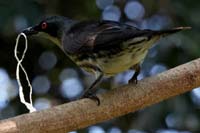
Out
of focus background highlights with diffraction grid pattern and
aperture diaphragm pattern.
The hexagonal pattern of the aperture
diaphragm is notable in the background.
In this photo of a
white-eared catbird in the San Diego Zoo, I stopped the lens down to
f/10 to try to squeeze depth of field out of the image. This is shot
hand-held in the shade at ISO 800, 1/100th sec at 185mm with a 20D. The
image-stabilization saved the day. |
|
Other comments on performance characteristics of the EF 70-300mm
f/4.5-5.6 DO IS USM lens
- Image stabilization: This feature works well and is highly
valuable for shooting at slow shutter speeds in low ambient light or
medium lighting with low ISO settings.
- Autofocus speed: Autofocus is very fast with cameras ranging from
the D-60 to the EOS-1D Mark II and much faster than that for the EF
75-300mm f/4-5.6 III USM.
- Backround blur / bokeh: Softly blurred out of focus
background was comparable to other quality Canon telephoto zoom lenses
at the same aperture.
- Construction: Finish and overall construction appears to be
very good and at a level comparable to the EF 28-135mm f/3.5-5.6 IS USM
lens.
- Zoom-lock switch: The lock on the zoom control will fix the
lens at the 70mm setting. I looked at two samples of the lens. One of
the lenses would extend to the 300mm setting when you carry it around on
a camera strap or otherwise point the lens down. This zoom creep can be
annoying.
- Stealthy: This lens is compact, black and more readily
overlook when you are carrying it than a longer, white 70-200 L-zoom.
- NOT quite a 300mm lens (at times): Official Canon lens
specifications from
Canon
USA state that the 70-300 DO lens has a diagonal field of view of
8° 15' (the same as their 300mm prime lenses). When focused at less
than infinity at the 300mm setting, the 70-300 DO has a wider field of
view than a 300mm prime lens. A
simple examination of image fields produced with a full frame
camera on a tripod with a set focus point and constant working distance
shows that the 70-300 has a wider field of view than a 300mm prime lens.
Using Polarizing and UV filters with the EF 70-300mm f/4.5-5.6 DO IS
USM lens
A lens
tip page by Xavier Henri pointed out benefits and disadvantages of
using filters with the lens:
- UV filters can decrease image contrast and color saturation under
some lighting conditions. If you use a protective filter, it should be a
clear filter, not a UV filter for best performance results.
See examples
- Circular polarizing filters work well to enhance sky-cloud contrast
and to reduce reflections. See
examples
Conclusions:
The Canon EF 70-300mm f/4.5-5.6 DO IS USM is a compact, very
fast-focusing zoom telephoto lens that provides generally excellent
imaging function including excellent image stabilization at a high price.
It is a weak performer at 300mm. It generally provides noticeably better
performance than the cheaper consumer 75-300mm lens. Under some lighting
conditions (e.g., backlighting of subject into the lens), the lens flares
and renders images unusable. Because of its compactness and generally
excellent performance with image stabilization, the lens is very useful
for travel or other applications where you don't want to carry a heavy,
long and easily noticed lens.
Gallery of images taken
with the EF 70-300mm f/4.5-5.6 DO IS USM and Canon D60
Equipment
Review Index
Home
©
2004, William L. Castleman
Posted
07 August 2004; last revised 06 June 2007


